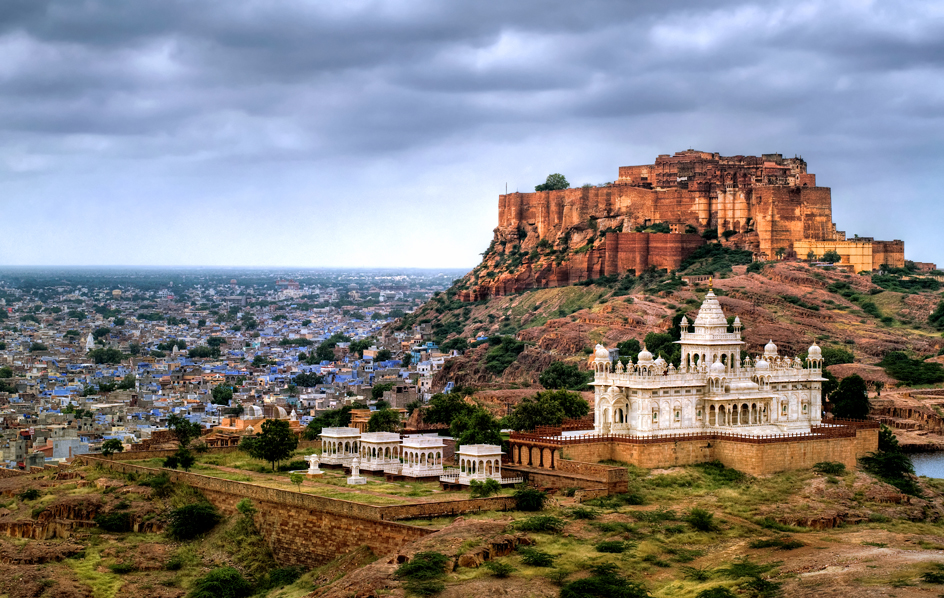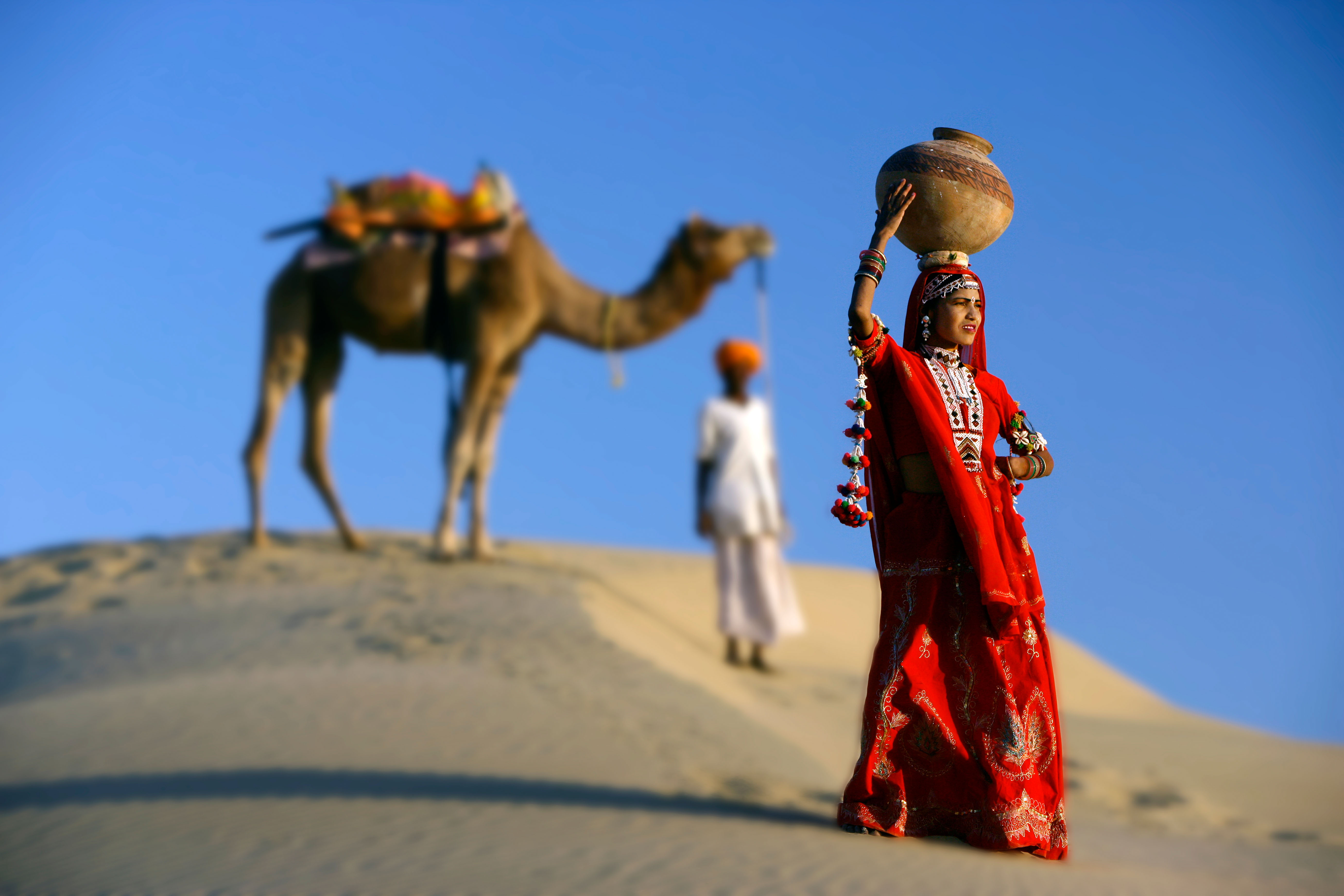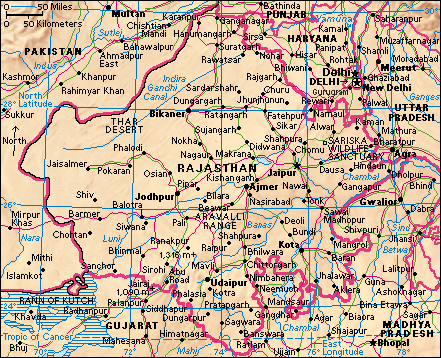Rajasthan (pop. 68,548,437) is a state in northwestern India. It covers 132,139 square miles (342,239 square kilometers) and is the largest state in the country. Rajasthan means “the land of the rajahs (or kings).” The state has a long border with Pakistan and contains a large desert area. The state capital is Jaipur.

People and government
People.
People who belong to ethnic groups known as tribes make up more than 12 percent of the state population. The main tribes are the Bhils and Minas. The smaller ones include the Sahariyas, the Damariyas, the Garasias, the Gadia Lohars, and the Bhil-Minas. The tribes share common characteristics, which seem to link their pasts. But differences in clothing, jewelry, gods, and festivals set them apart from one another.
The Bhils form an important group in the southern part of the state around Dungapur, Udaipur, and Chitorgarh. Their stronghold is Banswara. Their name derives from bil (bow) which describes their original talent and strength. The Mahabharata, a Hindu epic poem, mentions the Bhils and their archery skills (see Mahabharata).
The Minas are Rajasthan’s largest and most widely spread tribal group. In the north, they inhabit the Sikar belt of Shekhavati. In the southwest, the Mina settlements mix with the Bhils of Bundi-Kota-Jhalawar.
The Gadia Lohars are nomadic blacksmiths, who travel from place to place. Their name derives from their beautiful gadis (bullock carts). The Garasias are probably descendants of the Chauhan Rajputs of Jalore in southwest Rajasthan. The Sahariyas are jungle dwellers.
The Rajputs are an important section of the population, though they only represent a small percentage of the people of the state. The Rajputs claim to be the original kshatriyas (warriors) of the ancient varna system (Hindu division of society). They are probably descendants of the Huns and Scythians who entered India in the 500’s. The Jats are people living in the north and west of Rajasthan and are primarily an agricultural people. They are prominent in Bharatpur and Dholpur. The Gujars are mostly cattle breeders and are found in the eastern part of the state. The Kathodis inhabit the forest tract of the Aravalli range. The Sahariyas lead a primitive life while the Rebaris are cattle breeders.

The state’s main language is Rajasthani, which comprises a number of Indo-Aryan dialects. The four most important of these are Marwari (west), Jaipuri (east), Malwi (southeast) and Mewati (northwest). Hindi is rapidly replacing Rajasthani as the main language.
Hinduism is the religion of most people in Rajasthan. Jainism is also significant. Islam extended into the region with the conquest by Ajmer in the 1100’s, and is still widely practiced. Sikhs and Christians form extremely small minorities.
Rajasthan has a smaller population density than the rest of India. It is also one of the poorest states. Large numbers of people, especially women, are unable to read and write.
The state’s economy depends mainly on agriculture. However, the state also has good mineral resources. Tourism makes a large contribution to the regional economy.
Government.
The head of state is the governor, who is appointed by the president of India for a five-year term. The legislative assembly in Jaipur, the state capital, has 200 members. They include representatives of the tribal groups.
Rajasthan has 25 elected members of the Lok Sabha (lower house) and 10 nominated representatives in the Rajya Sabha (upper house) of the Indian national parliament.
At the district level, the chief administrative officer is called the collector. At the local level, there are gram panchayats, or village councils, most of which are made up of elected members. Rajasthan was the first state to experiment with this system of government. Some panchayat seats are reserved for women.
Economy
Agriculture.
About one-fifth of Rajasthan’s cultivated area is irrigated. Most of the farmed area depends on rainfall, which is low and unreliable. In the drier areas, the main crops are bajra (millet), oil seeds, tobacco, and wheat. Elsewhere, jowar (sorghum), corn, and pulses, such as peas, beans, and gram (lentils) are grown. Cotton is an important cash crop.
Rajasthan receives water from the Punjab rivers in the west and the Narmada in the south. The Gurgaon Canal supplies water from Haryana and the Agra Canal brings water from Uttar Pradesh. The state shares the Bhakra Dam project with Punjab. The Chambal Valley project, including the Rana Pratap Sagar and other dams, is shared with Madhya Pradesh. The largest canal within the state is the Indira Gandhi (formerly Rajasthan) Canal.
Farmers graze livestock in some areas that are too dry for cultivation. Rajasthan has a large livestock population, including camels. It is India’s largest wool producing state.
Manufacturing.
The main products are dyes, textiles, rugs and woollen goods, and vegetable oil. Heavy industry includes the construction of railroad cars, and copper and zinc smelting. The chemical industry produces calcium carbides, sodium hydroxide, and sulfuric acid. Chemical plants also manufacture fertilizers, insecticides, and pesticides. There is a rapidly expanding light industry, which includes assembling television sets. Precision instruments are manufactured at Kota. The main industrial complexes are at Jaipur, Kota, Udaipur, and Bhilwara.
Traditional handicrafts include pottery, jewelry, marble work, embossed brass, block printing, embroidery, and decorative painting. They are now popular with foreign buyers.
Mining.
Rajasthan accounts for the country’s entire output of emeralds, garnets, and zinc concentrates. It also produces most of India’s asbestos, feldspar, gypsum, and silver ore, and much of the country’s mica. The state has rich salt deposits at Sambhar and other places. There are copper mines at Khetri and Dariba. The white marble used to build the Taj Mahal was mined at Makrana near Jodhpur.
Transportation.
Rajasthan has an extensive network of roads. The rail system extends to Jaisalmer and Barmer on the edge of the Thar Desert and provides good connections with Mumbai and Delhi. It also serves the neighboring states of Madhya Pradesh and Gujarat. Ajmer, Bikaner, Jodhpur, Jaipur, and Kota are the main junctions. Air services link the major centers and connect them with the neighboring states. They also serve Mumbai and Delhi.
Tourism.
Rajasthan is one of India’s most popular tourist destinations. Its attractions include temples, forts, palaces, and nature reserves. There are camel safaris from Jaisalmer. Visitors can also travel on the Palace on Wheels luxury train, which was once the property of various princes.
Land
Location and description.
Rajasthan shares an international border on the west and northwest with Pakistan. Punjab and Haryana border it to the north, Uttar Pradesh to the east, Madhya Pradesh to the east and southeast, and Gujarat to the south and southwest. South of Banswara, Rajasthan lies within the Tropic of Cancer.
Land features.
The Aravalli Range runs from Mount Abu in the southwest to Khetri and beyond in the northeast. It divides the state in half and rises to 5,577 feet (1,700 meters). To the northwest is the Thar desert. This region is arid, sandy, and far less productive than the land to the southeast. Around Mewar the land is hilly. It is flat around Bharatpur and forms part of the Yamuna (or Jumna) drainage basin. There is a plateau near Kota and Bundi.

The soils in the northwest of the state are dry, and sandy. They are more fertile on the eastern and northeastern margins. In Jaipur and Alwar, in the center and west of the state, the soils are sandy and loamy. Only around Kota and Bundi are there good, black, deep, and well-drained soils.
Climate.
The climate varies widely in Rajasthan. Except in the hills, the summer temperatures are extremely high, with a maximum of 115 °F (46 °C) and an average from May to August of 100 °F (38 °C). The daily summer minimum is 77 °F (25 °C). In winter, the daily maximum in most low-lying areas is between 72 °F and 82 °F (22 and 28 °C), and the minimum between 46 °F and 57 °F (8 and 14 °C).
Rainfall varies over the state. Parts of the western desert receive only 4 inches (10 centimeters) a year. Jaisalmer has an annual rainfall of 8 inches (21 centimeters), 90 percent of which falls during the monsoon, between July and September (see Monsoon). Jaipur receives 26 inches (65 centimeters) of rain annually, 80 percent of which falls during the monsoon. Jodhpur, midway between these two places has 15 inches (38 centimeters) of rainfall a year. The Aravalli Range receives a higher rainfall and experiences lower temperatures throughout the year. To the southwest there is a higher rainfall and high humidity.
Plants and animals.
The natural vegetation of most of the state is scrub jungle. Trees are scarce, except in well wooded areas such as Kumbhalgarh in the southeast and in the eastern parts of the state. Tamarisk and arid zone plants grow in the west.
The natural jungle is ideal territory for chital (small spotted deer), leopards, sambhar (large brown deer), sloth bear, and tigers. These animals are now only rarely found outside game reserves. Black buck, nilgai (blue bulls), and ravine deer are fairly numerous on the plains.
The birdlife of the region is varied. Bikaner is famous for its sand grouse. Bharatpur and other low-lying swampy areas in the southeast of the state are popular winter grounds for migratory birds from Siberia and northern Europe.
Rivers and lakes.
The Aravalli Range forms the watershed (the divide between two river systems). The only major river in the northwest is the Luni, which rises in the Pushkar Valley and flows southwest to the Rann of Kutch. All the other rivers have their source in the Aravalli hills and flow to the north before joining the Luni. On the southern side of the range, the Bandi, Dhund, and Mashi rivers rise between Kishangarh and Jaipur and join the Berach, flowing northeast from Eklingi to form the Banas River. The Banas is the main tributary of the Chambal River. Farther north, the Banganga flows eastward from its source near Jaipur to join the Yamuna River.
Nearly all the lakes in the state are artificial reservoirs. The most famous is the Pichola Lake at Udaipur, in the middle of which is the former summer palace of the Maharanas. It is now a luxury hotel.
History
Prehistoric people lived along the Banas River 100,000 years ago. Archaeologists have found evidence of the Harappan and post-Harappan cultures, which flourished from about 2600 to about 1900 B.C. (see Indus Valley civilization). Some of the pottery at Kali Banga dates from 2700 B.C.
Rock inscriptions discovered near Bairat reveal that the Mauryan emperor Ashoka controlled part of the state in about 250 B.C. (see Ashoka). The Mauryans were followed by the Bactrian Greeks, the Scythians, the Guptas, and the Huns.
Rajput dynasties rose to political supremacy between the 600’s and the 1200’s. The Rajputs were a heroic warrior caste who lived by a strict code of chivalry and ritual. Upon the arrival of Islam in India, the Rajasthan region became a Hindu stronghold. Rajput strength reached its peak in the early 1500’s before the Mughal Babur defeated armies of Rajputana (see Mughal Empire).
Akbar, in a move to make peace with the Rajasthanis, married a Rajput princess and enlisted the services of Rajput nobles in his imperial service. Kings who did not serve Akbar were conquered.
In the 1700’s, Marathas, Pathans, and Pindaries all threatened Rajasthan. The Rajput rulers appealed for aid to the British East India Company. In the 1800’s, British influence gradually extended into the state. The British allowed the princes of the independent states to run the internal affairs of their territories as they wished. But a British representative controlled external matters. He was responsible to the political officer for the whole province, who in turn answered to the governor. British troops helped the native rulers put down peasant rebellions during the period.
Ajmer became one of the centers of nationalist activity. When India gained independence in 1947, Rajasthan was an important part of the newly independent country. The princes gradually surrendered their powers to the central government and became ordinary citizens in 1971.
See also Akbar; Jaipur; Mughal Empire.
